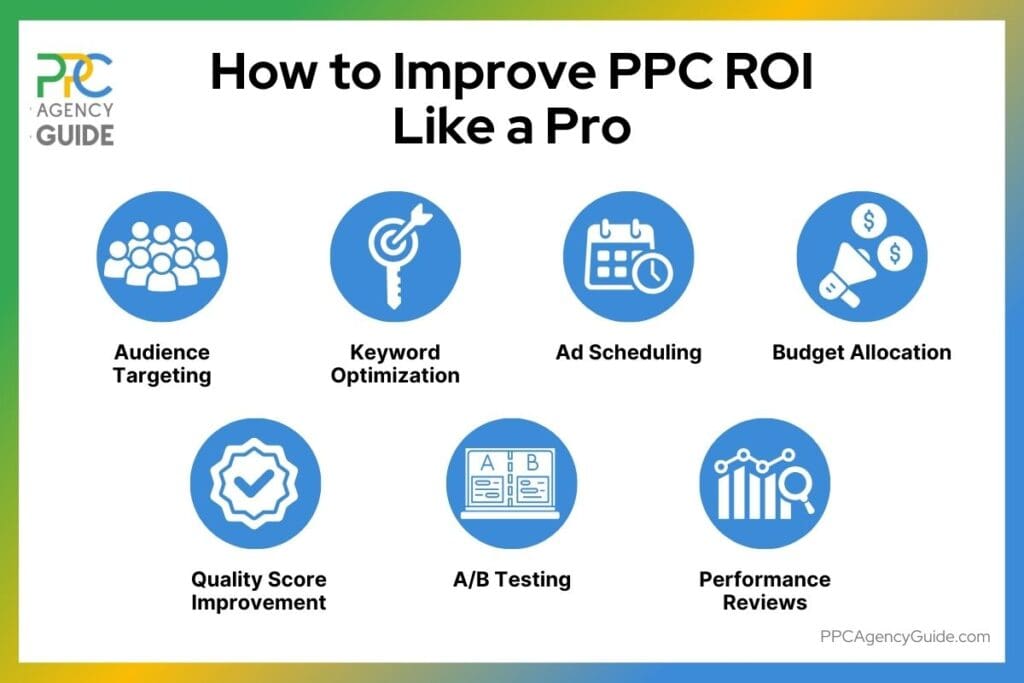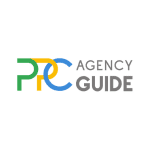
Businesses generate an average of $2 in revenue for each $1 spent on Google Ads, the platform reports. However, this naturally means that some will see a much higher return on investment (ROI), while others may not even break even. On this page, we’ll walk you through how to calculate your PPC ROI, explore factors that influence it, and walk you through specific steps to start improving your PPC ROI immediately.
PPC ROI Basics
Before we discuss how to measure and improve your PPC ROI, let’s briefly cover some background information.
Defining ROI in the Context of Pay-Per-Click Advertising
ROI is a key performance indicator that measures the profitability of an investment. In PPC advertising, ROI helps determine how effectively your ad spend translates into revenue.
Key PPC Metrics That Influence ROI
Understanding and optimizing key PPC metrics can significantly impact your ROI. Here are the most important ones.
Clickthrough Rate
Clickthrough rate (CTR) refers to the ratio of clicks to impressions, indicating how often people who see your ad click on it. A higher CTR means your ads are relevant to your target audience, which can improve your Quality Score and reduce your cost-per-click (CPC).
Cost-Per-Click
CPC refers to the amount you pay for each click on your ad. Lowering your CPC while maintaining ad quality can help maximize your ROI. This can be achieved by improving your ad relevance and Quality Score.
Conversion Rate
Conversion rate, sometimes abbreviated as CVR, is the percentage of clicks that result in a desired action, such as a purchase or lead submission. A higher conversion rate indicates that your landing pages and offers are compelling and relevant to your audience.
Cost-Per-Acquisition
Cost-per-acquisition (CPA) refers to the cost of acquiring a customer or lead through your PPC campaign. Keeping your CPA low while maintaining or increasing conversions helps improve your overall ROI.
Quality Score
Your ad Quality Score is a metric used by Google Ads that influences your ad rank and CPC based on the relevance and quality of your ads, keywords, and landing pages. A higher Quality Score can lower your CPC and improve your ad position, enhancing your ROI.

Lifetime Value
Lifetime value (LTV), sometimes called customer lifetime value (CLV) refers to the total revenue expected from a customer over the duration of their relationship with your business. Understanding LTV helps you determine how much you can afford to spend on acquiring customers through PPC.
Calculating ROI
Now that we’ve covered the basics, let’s explore how to calculate your PPC ROI.
Identifying Costs and Conversions in Your PPC Campaign
To accurately calculate your PPC ROI, it’s essential to identify all the costs associated with your PPC campaign and the conversions generated by it. Areas to consider are outlined below.
Costs
- Ad Spend: The total amount spent on running your PPC ads. This includes the CPC for each click on your ads.
- Ad Creation Costs: Any expenses related to creating your ads, such as graphic design, copywriting, or video production.
- Landing Page Development: Costs associated with creating and maintaining the landing pages where users are directed after clicking your ads.
- PPC Management Tools: Subscription fees for PPC management tools or software.
- Agency Fees: If you’re using a digital marketing agency, include their fees in your cost calculations.
- Internal Labor Costs: Wages for employees who manage and optimize your PPC campaigns.
Conversions
A conversion is any desired action taken by a user after clicking your ad. This could be a purchase, lead form submission, sign-up, or any other goal you’ve set. Use tools like Google Ads conversion tracking, Google Analytics, or other tracking software to monitor and record conversions accurately.
PPC ROI Formula
ROI = ((Revenue from PPC Campaign – Cost of PPC Campaign) ÷ Cost of PPC Campaign) x 100
This formula provides a percentage that indicates the return generated from your PPC investment. For example, if you spend $1,000 on a PPC campaign and generate $3,000 in revenue, your ROI would be 200 percent.
Advanced Insights
For advanced calculations, businesses can consider:
- Attribution Models: Use different attribution models, such as first-click, last-click, and multi-touch, to understand how various touchpoints contribute to conversions and revenue.
- Customer Lifetime Value: Incorporate CLV to measure the long-term value of customers acquired through PPC, providing a more comprehensive view of ROI.
- Incremental Lift Analysis: Assess the incremental impact of your PPC campaigns by comparing periods with and without PPC activity, isolating the effect of the campaigns from other marketing efforts.
Factors Affecting PPC ROI
A variety of things can impact your PPC ROI. We’ll explore some of the most common issues below.
Clickthrough Rates
CTR is a crucial metric in PPC advertising that measures the ratio of users who click on your ad to the number of total users who view the ad (impressions). Here’s how CTR impacts PPC ROI.
Ad Relevance and Quality Score
A higher CTR indicates that your ad is relevant and engaging to your target audience. Search engines like Google use CTR as a factor in determining your ad’s Quality Score.
A high Quality Score can lead to better ad placements and lower costs-per-click (CPC), effectively increasing your ROI. Conversely, a low CTR can result in a lower Quality Score, higher CPCs, and reduced ROI.
Cost Efficiency
Higher CTRs mean more clicks for your ad spend, driving more potential customers to your website or landing page without increasing costs proportionately. This can improve the cost efficiency of your campaign and positively affect ROI.
For instance, if you have a CTR of two percent (two clicks per 100 impressions) compared to a CTR of one percent (one click per 100 impressions), you’ll get double the traffic for the same number of impressions, improving the chances of conversion and thus ROI.
Conversion Rates
Conversion Rate measures the percentage of users who complete a desired action after clicking your ad, such as making a purchase, filling out a form, or signing up for a newsletter. Here’s how conversion rates affect PPC ROI.
Revenue Generation
A higher conversion rate means that a greater proportion of the users who click on your ad are completing the desired action, leading to higher revenue from the same amount of traffic.
For example, if you have 100 clicks and a conversion rate of five percent, you get five conversions. If your average revenue per conversion is $100, you generate $500 in revenue. If you increase your conversion rate to ten percent, you get 10 conversions and $1,000 in revenue, significantly boosting ROI.
Cost-Per-Acquisition (CPA)
Conversion rate directly impacts your CPA, which is the cost incurred to acquire a single conversion. Lower CPAs are generally desirable as they mean you’re spending less to achieve each conversion, improving overall ROI.
For instance, with a conversion rate of two percent, if you spend $100 on ads, you get two conversions, making your CPA $50. By improving your conversion rate to four percent, you get four conversions for the same spend, reducing your CPA to $25 and enhancing your ROI.
Optimization Opportunities
High conversion rates indicate that your landing pages, offers, and overall user experience are effective, making it easier to justify increased ad spend since you’re getting better returns on your investment.
Conversely, low conversion rates suggest areas for improvement in your landing pages or sales funnel. Addressing these issues can lead to higher conversion rates and, consequently, better ROI.
Leveraging Google Analytics for ROI Measurements
Google Analytics is a powerful tool for tracking and measuring the effectiveness of your PPC campaigns. A thorough PPC audit can ensure your tracking setup, goals, and attribution models are aligned with your campaign objectives. Learn how to conduct an audit with our PPC Audit Guide.
Setting Up Goals and Conversions
Define specific actions you want users to take on your website, such as making a purchase, filling out a contact form, or signing up for a newsletter. Then, set up conversion tracking by linking your Google Ads account with Google Analytics. This allows you to track how many conversions are coming from your PPC campaigns.
E-commerce Tracking
If you run an e-commerce site, enable e-commerce tracking in Google Analytics. This will provide detailed data on revenue, transaction volume, and other key metrics directly tied to your PPC efforts.
Multi-Channel Funnels
Use Multi-Channel Funnels to see how different marketing channels, including PPC, contribute to conversions. This helps in understanding the full customer journey and the role PPC plays in driving conversions.
Attribution Models
Google Analytics offers various attribution models to analyze how different interactions impact conversions. Choose an appropriate model to understand the true impact of your PPC campaigns on ROI.
Custom Reports and Dashboards
Create custom reports and dashboards to track key metrics like clicks, conversions, revenue, and ROI. This allows for quick insights and easier monitoring of campaign performance.
Improving Your PPC ROI
Now that we’ve covered the preliminary steps, let’s dig into some of the things you can do to boost your PPC ROI.

Targeting the Right Audience
- Audience Segmentation: Use demographic, geographic, and behavioral data to segment your audience. Create tailored ads for each segment to increase relevance and engagement.
- Remarketing: Target users who have previously interacted with your website but did not convert. Remarketing can help bring back potential customers and improve conversion rates.
- Custom Audiences: Create custom audiences based on specific criteria such as past purchases, website behavior, or engagement with previous ads.
Keyword Optimization
- Negative Keywords: Identify and exclude irrelevant keywords that trigger your ads but do not lead to conversions. This helps in reducing wasted ad spend.
- Long-Tail Keywords: Focus on long-tail keywords that have lower competition and are more likely to convert. These keywords often have lower CPCs and higher conversion rates.
Ad Scheduling
- Dayparting: Analyze performance data to determine the best times and days to run your ads. Schedule your ads to appear when your target audience is most active and likely to convert.
- Ad Rotation: Test different ad creatives and rotate them to identify which ones perform best. Use the winning ads more frequently to optimize ad spend.
Budget Allocation
- Performance-Based Budgeting: Allocate more budget to high-performing campaigns, keywords, and ad groups. Reduce spend on underperforming areas.
- Bid Adjustments: Use bid adjustments to increase or decrease bids based on device, location, and time of day. This helps in optimizing ad spend for better ROI.
Quality Score Improvement
- Ad Relevance: Ensure your ad copy is closely related to the keywords you’re targeting. This improves your Quality Score and reduces CPC.
- Landing Page Experience: Optimize your landing pages for better user experience. Ensure they load quickly, are mobile-friendly, and have clear calls to action. A better landing page experience can lead to higher conversion rates and improved Quality Score.
A/B Testing
- Ad Copy: Test different headlines, descriptions, and calls-to-action to identify which combinations yield the highest CTR and conversion rates.
- Landing Pages: Create multiple versions of your landing pages and test them to determine which design, layout, and content perform best.
- Bidding Strategies: Experiment with different bidding strategies (e.g., manual CPC, target CPA, target ROAS) to find the most cost-effective approach for your campaigns.
Regular Performance Reviews
- Weekly and Monthly Reviews: Conduct regular reviews of your PPC campaigns to monitor performance metrics like CTR, conversion rate, CPA, and ROI. Identify trends and make data-driven adjustments.
- Competitor Analysis: Keep an eye on your competitors’ PPC strategies. Analyze their ads, keywords, and landing pages to identify opportunities for improvement in your own campaigns.
Get Help Improving Your PPC ROI
An experienced agency can address all the above for you to help ensure your PPC ads are always delivering maximum ROI. If you’re ready to achieve professional results with your paid ads, request a complimentary consultation.
PPC ROI FAQ
What are the key metrics to track for PPC ROI?
Key metrics include Click-Through Rate (CTR), Cost-Per-Click (CPC), Conversion Rate, Cost-Per-Acquisition (CPA), and Quality Score. Tracking these helps evaluate ad performance, cost efficiency, and overall campaign effectiveness.
How do click-through rates (CTR) affect PPC ROI?
Higher CTRs indicate ad relevance, leading to better Quality Scores and lower CPCs. This increases traffic and potential conversions without significantly raising costs, thus improving ROI.
What impact do conversion rates have on PPC ROI?
Higher conversion rates mean more users complete desired actions, generating more revenue from the same ad spend. This reduces Cost-Per-Acquisition (CPA) and significantly boosts PPC ROI.
What tools can I use to measure PPC ROI?
Tools like Google Analytics, SEMrush, WordStream, and Kenshoo offer detailed insights into ad performance, conversion tracking, and ROI calculation, helping optimize campaigns and maximize returns.
How can Google Analytics help in tracking PPC ROI?
Google Analytics tracks conversions, revenue, and user behavior. By setting up goals and linking Google Ads, it provides detailed insights into campaign performance, helping measure and improve PPC ROI.
What strategies can optimize ad spend to improve PPC ROI?
Optimize ad spend by targeting the right audience, using negative keywords, focusing on long-tail keywords, scheduling ads during peak times, and improving Quality Scores through relevant ad copy and landing pages.
What are the benefits of working with a PPC agency for ROI improvement?
PPC agencies bring expertise, advanced tools, and industry insights. They efficiently manage campaigns, optimize ad spend, and apply data-driven strategies to enhance ad performance and ROI.
How can A/B testing refine my PPC campaigns?
A/B testing involves comparing different ad elements (headlines, descriptions, CTAs) and landing pages to identify which versions perform best. This continuous refinement improves CTR, conversion rates, and overall ROI.
What is the role of Quality Score in improving PPC ROI?
Quality Score affects ad rank and CPC. Higher scores, achieved through relevant ads and optimized landing pages, lower CPC and improve ad placement, enhancing cost efficiency and PPC ROI.
How do I track PPC ROI using cost and conversions?
To track PPC ROI, focus on the relationship between cost and conversions. Calculate total ad spend (cost) and measure the number of conversions your ads generate. By analyzing cost and conversions, you can determine the profitability of your campaigns and make data-driven decisions to optimize performance.


















